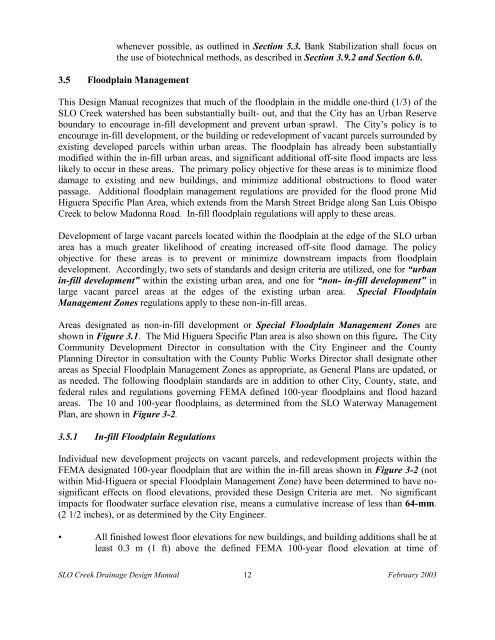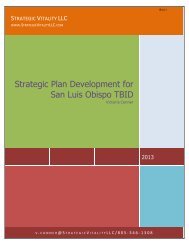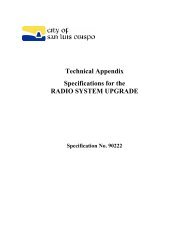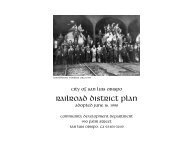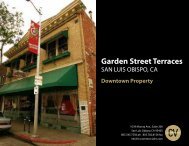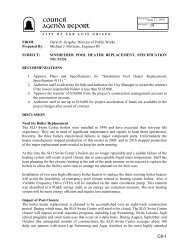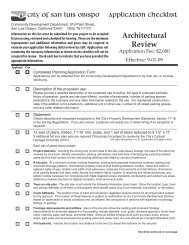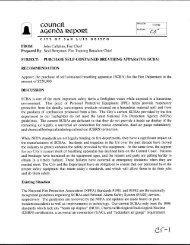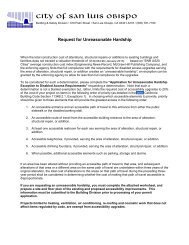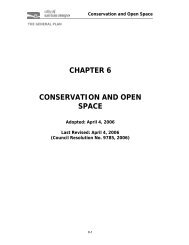Drainage Design Manual - the City of San Luis Obispo
Drainage Design Manual - the City of San Luis Obispo
Drainage Design Manual - the City of San Luis Obispo
Create successful ePaper yourself
Turn your PDF publications into a flip-book with our unique Google optimized e-Paper software.
whenever possible, as outlined in Section 5.3. Bank Stabilization shall focus on<strong>the</strong> use <strong>of</strong> biotechnical methods, as described in Section 3.9.2 and Section 6.0.3.5 Floodplain ManagementThis <strong>Design</strong> <strong>Manual</strong> recognizes that much <strong>of</strong> <strong>the</strong> floodplain in <strong>the</strong> middle one-third (1/3) <strong>of</strong> <strong>the</strong>SLO Creek watershed has been substantially built- out, and that <strong>the</strong> <strong>City</strong> has an Urban Reserveboundary to encourage in-fill development and prevent urban sprawl. The <strong>City</strong>’s policy is toencourage in-fill development, or <strong>the</strong> building or redevelopment <strong>of</strong> vacant parcels surrounded byexisting developed parcels within urban areas. The floodplain has already been substantiallymodified within <strong>the</strong> in-fill urban areas, and significant additional <strong>of</strong>f-site flood impacts are lesslikely to occur in <strong>the</strong>se areas. The primary policy objective for <strong>the</strong>se areas is to minimize flooddamage to existing and new buildings, and minimize additional obstructions to flood waterpassage. Additional floodplain management regulations are provided for <strong>the</strong> flood prone MidHiguera Specific Plan Area, which extends from <strong>the</strong> Marsh Street Bridge along <strong>San</strong> <strong>Luis</strong> <strong>Obispo</strong>Creek to below Madonna Road. In-fill floodplain regulations will apply to <strong>the</strong>se areas.Development <strong>of</strong> large vacant parcels located within <strong>the</strong> floodplain at <strong>the</strong> edge <strong>of</strong> <strong>the</strong> SLO urbanarea has a much greater likelihood <strong>of</strong> creating increased <strong>of</strong>f-site flood damage. The policyobjective for <strong>the</strong>se areas is to prevent or minimize downstream impacts from floodplaindevelopment. Accordingly, two sets <strong>of</strong> standards and design criteria are utilized, one for “urbanin-fill development” within <strong>the</strong> existing urban area, and one for “non- in-fill development” inlarge vacant parcel areas at <strong>the</strong> edges <strong>of</strong> <strong>the</strong> existing urban area. Special FloodplainManagement Zones regulations apply to <strong>the</strong>se non-in-fill areas.Areas designated as non-in-fill development or Special Floodplain Management Zones areshown in Figure 3.1. The Mid Higuera Specific Plan area is also shown on this figure. The <strong>City</strong>Community Development Director in consultation with <strong>the</strong> <strong>City</strong> Engineer and <strong>the</strong> CountyPlanning Director in consultation with <strong>the</strong> County Public Works Director shall designate o<strong>the</strong>rareas as Special Floodplain Management Zones as appropriate, as General Plans are updated, oras needed. The following floodplain standards are in addition to o<strong>the</strong>r <strong>City</strong>, County, state, andfederal rules and regulations governing FEMA defined 100-year floodplains and flood hazardareas. The 10 and 100-year floodplains, as determined from <strong>the</strong> SLO Waterway ManagementPlan, are shown in Figure 3-2.3.5.1 In-fill Floodplain RegulationsIndividual new development projects on vacant parcels, and redevelopment projects within <strong>the</strong>FEMA designated 100-year floodplain that are within <strong>the</strong> in-fill areas shown in Figure 3-2 (notwithin Mid-Higuera or special Floodplain Management Zone) have been determined to have nosignificanteffects on flood elevations, provided <strong>the</strong>se <strong>Design</strong> Criteria are met. No significantimpacts for floodwater surface elevation rise, means a cumulative increase <strong>of</strong> less than 64-mm.(2 1/2 inches), or as determined by <strong>the</strong> <strong>City</strong> Engineer.• All finished lowest floor elevations for new buildings, and building additions shall be atleast 0.3 m (1 ft) above <strong>the</strong> defined FEMA 100-year flood elevation at time <strong>of</strong>SLO Creek <strong>Drainage</strong> <strong>Design</strong> <strong>Manual</strong> 12 February 2003


